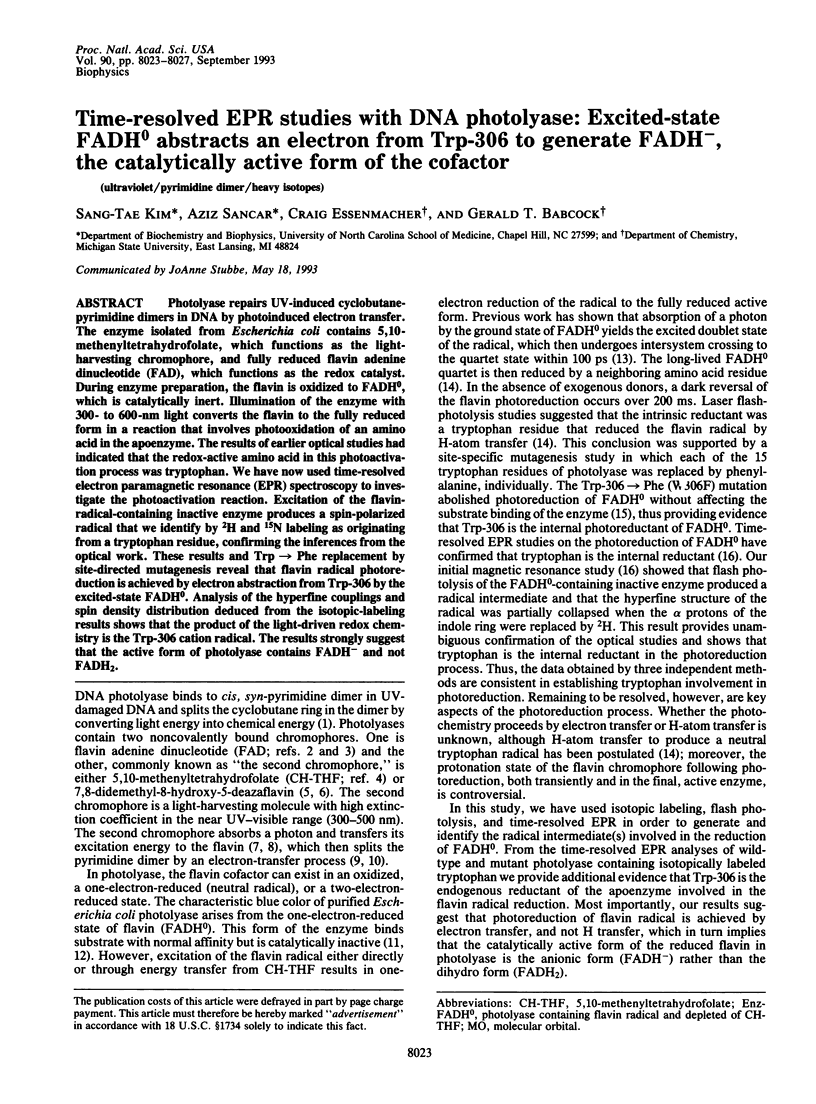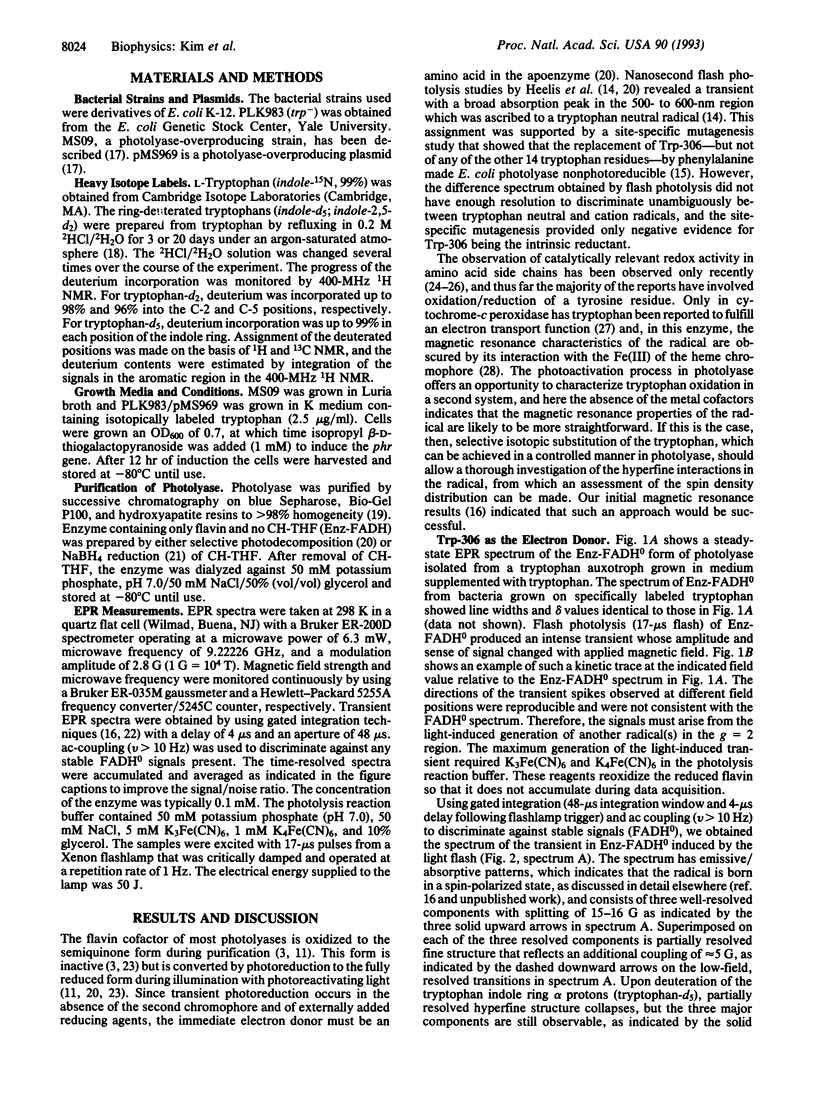Abstract
Photolyase repairs UV-induced cyclobutane-pyrimidine dimers in DNA by photoinduced electron transfer. The enzyme isolated from Escherichia coli contains 5,10-methenyltetrahydrofolate, which functions as the light-harvesting chromophore, and fully reduced flavin adenine dinucleotide (FAD), which functions as the redox catalyst. During enzyme preparation, the flavin is oxidized to FADH0, which is catalytically inert. Illumination of the enzyme with 300- to 600-nm light converts the flavin to the fully reduced form in a reaction that involves photooxidation of an amino acid in the apoenzyme. The results of earlier optical studies had indicated that the redox-active amino acid in this photoactivation process was tryptophan. We have now used time-resolved electron paramagnetic resonance (EPR) spectroscopy to investigate the photoactivation reaction. Excitation of the flavin-radical-containing inactive enzyme produces a spin-polarized radical that we identify by 2H and 15N labeling as originating from a tryptophan residue, confirming the inferences from the optical work. These results and Trp-->Phe replacement by site-directed mutagenesis reveal that flavin radical photoreduction is achieved by electron abstraction from Trp-306 by the excited-state FADH0. Analysis of the hyperfine couplings and spin density distribution deduced from the isotopic-labeling results shows that the product of the light-driven redox chemistry is the Trp-306 cation radical. The results strongly suggest that the active form of photolyase contains FADH- and not FADH2.
Full text
PDF




Selected References
These references are in PubMed. This may not be the complete list of references from this article.
- Barry B. A. The role of redox-active amino acids in the photosynthetic water-oxidizing complex. Photochem Photobiol. 1993 Jan;57(1):179–188. doi: 10.1111/j.1751-1097.1993.tb02275.x. [DOI] [PubMed] [Google Scholar]
- Eker A. P., Kooiman P., Hessels J. K., Yasui A. DNA photoreactivating enzyme from the cyanobacterium Anacystis nidulans. J Biol Chem. 1990 May 15;265(14):8009–8015. [PubMed] [Google Scholar]
- Ghisla S., Massey V., Lhoste J. M., Mayhew S. G. Fluorescence and optical characteristics of reduced flavines and flavoproteins. Biochemistry. 1974 Jan 29;13(3):589–597. doi: 10.1021/bi00700a029. [DOI] [PubMed] [Google Scholar]
- Heelis P. F., Okamura T., Sancar A. Excited-state properties of Escherichia coli DNA photolyase in the picosecond to millisecond time scale. Biochemistry. 1990 Jun 19;29(24):5694–5698. doi: 10.1021/bi00476a008. [DOI] [PubMed] [Google Scholar]
- Heelis P. F., Payne G., Sancar A. Photochemical properties of Escherichia coli DNA photolyase: selective photodecomposition of the second chromophore. Biochemistry. 1987 Jul 28;26(15):4634–4640. doi: 10.1021/bi00389a007. [DOI] [PubMed] [Google Scholar]
- Hoffman B. M., Roberts J. E., Kang C. H., Margoliash E. Electron paramagnetic and electron nuclear double resonance of the hydrogen peroxide compound of cytochrome c peroxidase. J Biol Chem. 1981 Jul 10;256(13):6556–6564. [PubMed] [Google Scholar]
- Hoganson C. W., Babcock G. T. Protein-tyrosyl radical interactions in photosystem II studied by electron spin resonance and electron nuclear double resonance spectroscopy: comparison with ribonucleotide reductase and in vitro tyrosine. Biochemistry. 1992 Dec 1;31(47):11874–11880. doi: 10.1021/bi00162a028. [DOI] [PubMed] [Google Scholar]
- Johnson J. L., Hamm-Alvarez S., Payne G., Sancar G. B., Rajagopalan K. V., Sancar A. Identification of the second chromophore of Escherichia coli and yeast DNA photolyases as 5,10-methenyltetrahydrofolate. Proc Natl Acad Sci U S A. 1988 Apr;85(7):2046–2050. doi: 10.1073/pnas.85.7.2046. [DOI] [PMC free article] [PubMed] [Google Scholar]
- Jorns M. S., Wang B., Jordan S. P. DNA repair catalyzed by Escherichia coli DNA photolyase containing only reduced flavin: elimination of the enzyme's second chromophore by reduction with sodium borohydride. Biochemistry. 1987 Oct 20;26(21):6810–6816. doi: 10.1021/bi00395a034. [DOI] [PubMed] [Google Scholar]
- Kiener A., Husain I., Sancar A., Walsh C. Purification and properties of Methanobacterium thermoautotrophicum DNA photolyase. J Biol Chem. 1989 Aug 15;264(23):13880–13887. [PubMed] [Google Scholar]
- Kim S. T., Heelis P. F., Okamura T., Hirata Y., Mataga N., Sancar A. Determination of rates and yields of interchromophore (folate----flavin) energy transfer and intermolecular (flavin----DNA) electron transfer in Escherichia coli photolyase by time-resolved fluorescence and absorption spectroscopy. Biochemistry. 1991 Nov 26;30(47):11262–11270. doi: 10.1021/bi00111a011. [DOI] [PubMed] [Google Scholar]
- Kim S. T., Rose S. D. Pyrimidine dimer splitting in covalently linked dimer-arylamine systems. J Photochem Photobiol B. 1992 Jan 31;12(2):179–191. doi: 10.1016/1011-1344(92)85007-h. [DOI] [PubMed] [Google Scholar]
- Kim S. T., Sancar A. Effect of base, pentose, and phosphodiester backbone structures on binding and repair of pyrimidine dimers by Escherichia coli DNA photolyase. Biochemistry. 1991 Sep 3;30(35):8623–8630. doi: 10.1021/bi00099a019. [DOI] [PubMed] [Google Scholar]
- Li Y. F., Heelis P. F., Sancar A. Active site of DNA photolyase: tryptophan-306 is the intrinsic hydrogen atom donor essential for flavin radical photoreduction and DNA repair in vitro. Biochemistry. 1991 Jun 25;30(25):6322–6329. doi: 10.1021/bi00239a034. [DOI] [PubMed] [Google Scholar]
- Li Y. F., Sancar A. Cloning, sequencing, expression and characterization of DNA photolyase from Salmonella typhimurium. Nucleic Acids Res. 1991 Sep 25;19(18):4885–4890. doi: 10.1093/nar/19.18.4885. [DOI] [PMC free article] [PubMed] [Google Scholar]
- Lipman R. S., Jorns M. S. Direct evidence for singlet-singlet energy transfer in Escherichia coli DNA photolyase. Biochemistry. 1992 Jan 28;31(3):786–791. doi: 10.1021/bi00118a021. [DOI] [PubMed] [Google Scholar]
- Malhotra K., Kim S. T., Walsh C., Sancar A. Roles of FAD and 8-hydroxy-5-deazaflavin chromophores in photoreactivation by Anacystis nidulans DNA photolyase. J Biol Chem. 1992 Aug 5;267(22):15406–15411. [PubMed] [Google Scholar]
- Payne G., Heelis P. F., Rohrs B. R., Sancar A. The active form of Escherichia coli DNA photolyase contains a fully reduced flavin and not a flavin radical, both in vivo and in vitro. Biochemistry. 1987 Nov 3;26(22):7121–7127. doi: 10.1021/bi00396a038. [DOI] [PubMed] [Google Scholar]
- Sancar A., Sancar G. B. Escherichia coli DNA photolyase is a flavoprotein. J Mol Biol. 1984 Jan 15;172(2):223–227. doi: 10.1016/s0022-2836(84)80040-6. [DOI] [PubMed] [Google Scholar]
- Sivaraja M., Goodin D. B., Smith M., Hoffman B. M. Identification by ENDOR of Trp191 as the free-radical site in cytochrome c peroxidase compound ES. Science. 1989 Aug 18;245(4919):738–740. doi: 10.1126/science.2549632. [DOI] [PubMed] [Google Scholar]
- Sjöberg B. M., Reichard P., Gräslund A., Ehrenberg A. The tyrosine free radical in ribonucleotide reductase from Escherichia coli. J Biol Chem. 1978 Oct 10;253(19):6863–6865. [PubMed] [Google Scholar]


